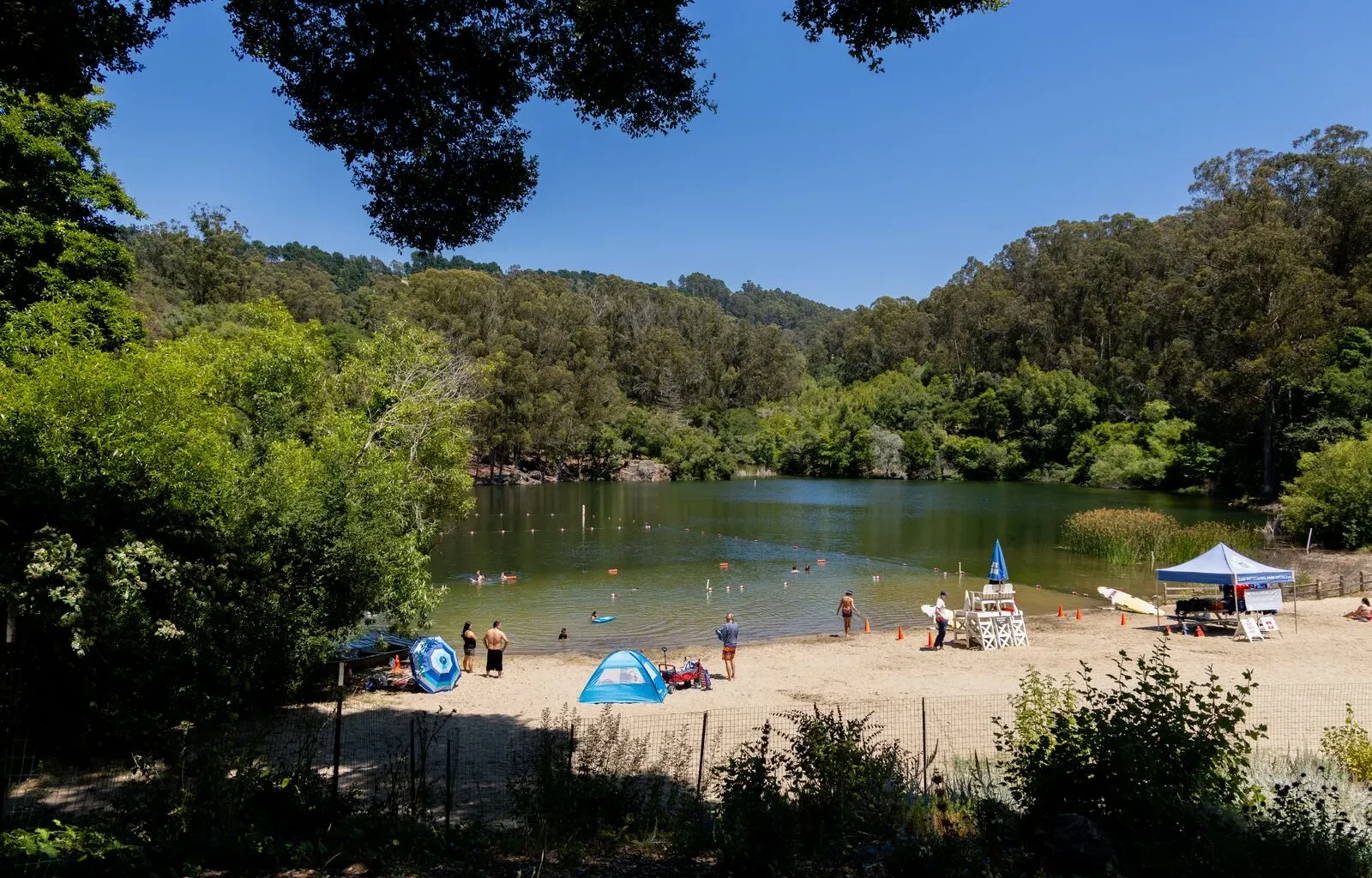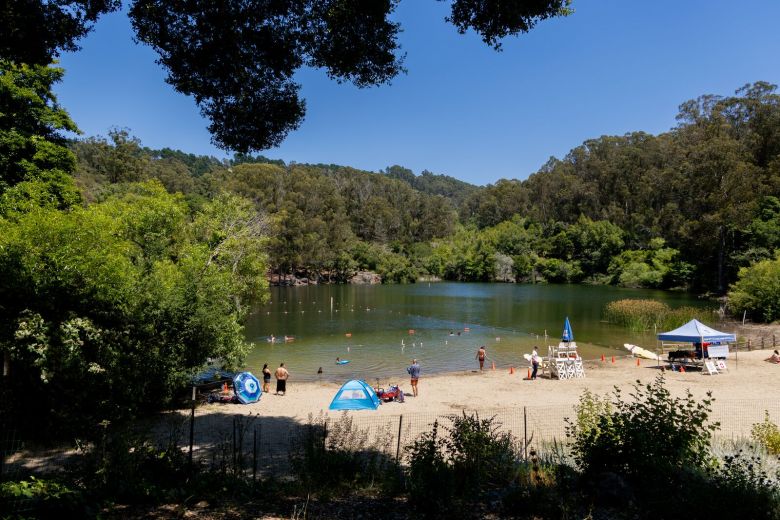 Swimmers enter Lake Anza in Tilden Monday afternoon. Credit: Sara Martin/Berkeleyside
Swimmers enter Lake Anza in Tilden Monday afternoon. Credit: Sara Martin/Berkeleyside
The swim season this year at Lake Anza, which began on April 26, has been busy.
On a hot, sunny day, “700 people will come through the gate,” said Luke Beals, a lifeguard at the Tilden lake. “We’ll see about 100 people in the water at once.”
But until recently, it wasn’t certain whether there would be a swim season at all.
For a decade, harmful algae blooms have been spotted at Lake Anza and other East Bay lakes, closing them periodically to swimmers. Lake Anza was entirely closed to swimmers from 2020 to 2022 due, mostly, to the toxic blue-green algae. Last year, an algae bloom resulted in danger advisories that cut the usually April-to-September swimming season to 77 days, ending June 17.
After treatments by the East Bay Regional Park District (EBRPD) earlier this year, the lake is currently safe for swimmers, with no dangerous toxin levels detected. According to the latest weekly water quality status report, E. Coli bacteria levels are currently below the state’s health standards and there’s a “low health risk for water contact.”
“We’re hopeful that the treatments we did earlier this spring will keep it open through most of the year,” said Matthew Graul, chief of stewardship at the park district. “There’s no guarantee, so I would encourage people to look at our website before they come out (to swim).”
But the underlying problem that the park district believes led to last year’s algae bloom still remains in need of a permanent solution, which the district won’t attempt until at least 2026.
What causes Lake Anza to turn toxic?
Cyanobacteria, commonly called blue-green algae, is present in ocean and freshwater around the world. It tends to bloom when certain conditions are met: low water levels, limited circulation and warm temperatures.
Cyanobacteria can be found naturally growing in oceans and water bodies across the world. But man-made lakes like Lake Anza (which was created in 1938 when the Tilden Park dam was built) tend to become more eutrophic, or excessively filled with nutrients like phosphorus and nitrogen that feed cyanobacteria. That’s because when a stream channel flows into an open water body, the velocity of water slows down, depositing sediment — and nutrients — into the lake.
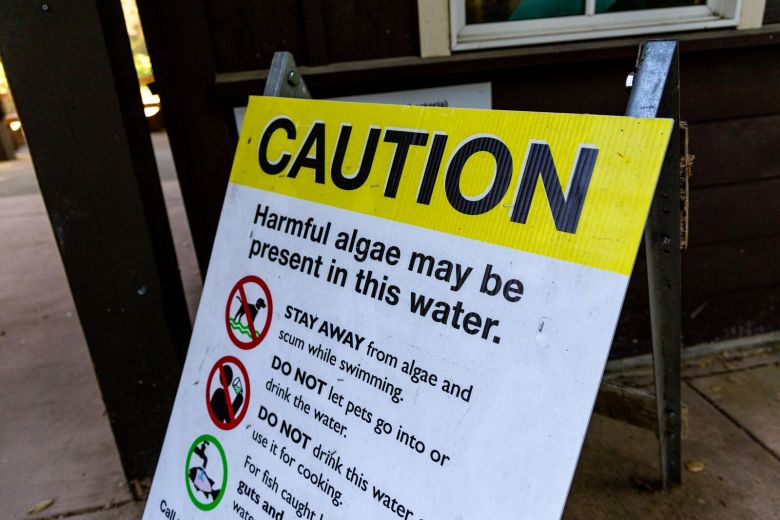 A caution sign posted at Lake Anza this week. Credit: Sara Martin/Berkeleyside
A caution sign posted at Lake Anza this week. Credit: Sara Martin/Berkeleyside
Climate change, which drives extreme weather, makes harmful algae blooms more likely, and they’re increasing worldwide. Heavy storms dump nutrient-filled sediment on the bottom of the lake. When followed by periods of drought, the stagnant water and warm temperatures create the perfect conditions for a harmful algal bloom.
Eutrophication sets off a chain reaction in the ecosystem. The excessive loads of nutrients result in algal blooms, which in large amounts deplete oxygen levels in the water and can result in mass marine die-offs like the one that impacted Lake Merritt in 2022.
What went wrong last year and what is the park district doing?
To reduce the frequency and duration of harmful algal blooms, the district in July 2020 installed a hypolimnetic oxygenation system in Lake Anza to bring dissolved oxygen to the depths of the lake (important to maintain its rainbow trout population).
But the oxygenation system “appears to be too strong for Lake Anza,” according to a 2024 EBRPD report on harmful algal blooms.
Last summer, bubbles from the system caused the colder, denser and nutrient-rich water at the bottom of the lake to float up and “mix the lake,” fueling the harmful algae growth. (Graul said harm to marine life in the lake was minimal.)
Oxygen levels in pipes buried at the bottom of the lake have been dropped to prevent this mixing from happening again this year, Graul said.
An upgraded model, called oxygen saturation technology, that uses a pump system to allow the park district to more easily moderate oxygen levels without creating any bubbles is being tested in Lake Temescal in Oakland, which also faces cyanobacterial blooms, Graul said.
“They take oxygen gas from nearby on the shore and saturate the water and release it into the lake,” Eli Kersh, whose company LakeTech, works to improve water quality in the East Bay, has said — describing the technology as expensive but “foolproof.”
If the experiment is successful at Lake Temescal, Graul said the park district “may consider options to retrofit or replace the system at Lake Anza” — likely in 2026.
This year for the first time, the park district is also using a water coagulant called aluminum chlorohydrate — which acts as a binding agent — that it hopes will help mitigate the release of sentimental nutrients like phosphorus and nitrogen-ammonia both from the surface and bottom of the lake, thereby improving water clarity and quality.
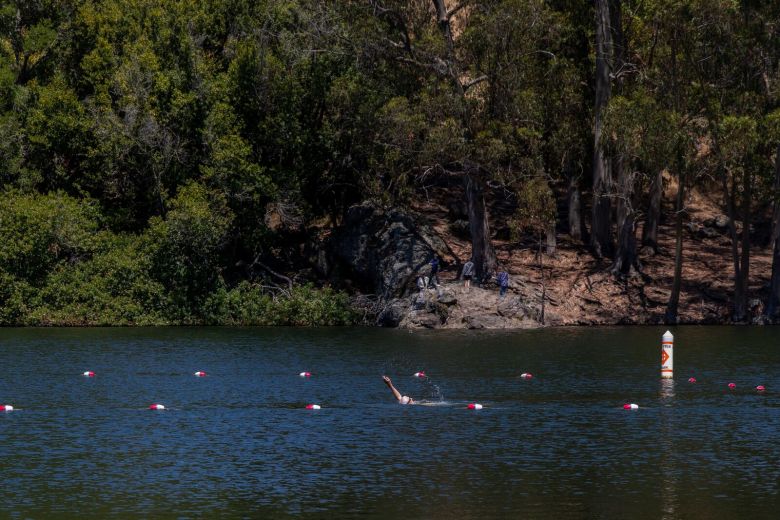 Lake Anza is a man-made lake that came into existence when the Tilden Park dam was built in 1938. Credit: Sara Martin/Berkeleyside
Lake Anza is a man-made lake that came into existence when the Tilden Park dam was built in 1938. Credit: Sara Martin/Berkeleyside
“It doesn’t work to completely eliminate them, but it reduces the frequency and magnitude of the algal blooms,” Graul said.
Another organism affecting swimmers at Lake Anza in recent years has been the Azolla fern, a squishy, green and brown plant that quickly took over much of the lake’s surface in 2022. The fern isn’t toxic, and actually helped to reduce the algae blooms, but creates an obstacle for swimmers. But it disappeared in 2023, likely washed away by heavy winter storms, and didn’t need treatment this year. The park district now has an aquatic harvester machine, purchased in 2023, that can cull the fern if needed.
This year’s treatments, including beach maintenance, said Graul, have cost the park district $84,500. The amount surpassed the previous year’s expenditures on the lake, according to Graul.
The work has included weekly water quality testing, which continues, and manual labor with “hand tools and rakes” to clear aquatic vegetation in the swim area “whenever the plants accumulate.”
Lifeguard says lake is cleanest it’s been in years
Beals, the Lake Anza lifeguard, said he and his colleagues swim 550 yards as a warm-up exercise in the morning whenever they are on duty and are amazed by the lake’s cleanliness.
“I’ve been a lifeguard here for three years now, and this year is the best year I’ve ever seen the lake,” he said.
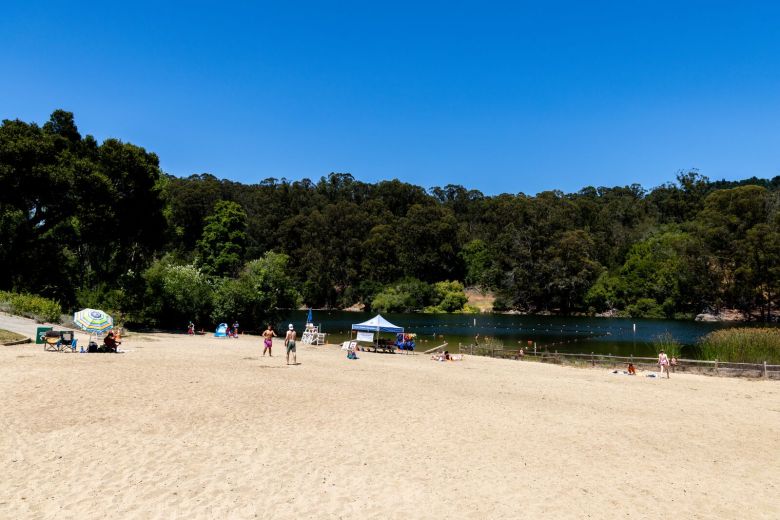 Park district officials are hopeful the swim season will stretch until mid-September. Credit: Sara Martin/Berkeleyside
Park district officials are hopeful the swim season will stretch until mid-September. Credit: Sara Martin/Berkeleyside
The lake opens for swimming at 11 a.m. and closes at 6 p.m. on weekdays and weekends.
People are still cautioned to avoid algae and scum while swimming, keep pets out of the lake and clean fish caught there with tap or bottled water. Several dog deaths in California have been attributed to toxic algae poisoning in recent years. And people should monitor the EBRPD website for water quality updates.
There were 3,212 swim attendances at Lake Anza in 2024, according to EBRPD spokesperson Dave Mason. That number could double this year with a full swim season.
While optimism is high, Mason struck a cautionary tone. Lake Anza and other bodies of water in the East Bay will continue to face water quality issues, he said.
“The changing climate has created challenges for water quality, which can limit recreation access, including open water swimming,” he said.
Iris Kwok and Zac Farber contributed reporting to this story.
“*” indicates required fields
